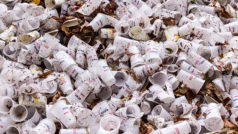This capacity consists of a large number of small to medium plants, averaging 10,000 tonnes, with the biggest facilities reaching over 40,000 tonnes.
These positive developments were propelled by simultaneous improvements in the collection, sorting and recycling of flexible plastics, which have led to the growing uptake of recyclates in a wider range of end applications.
Germany, Spain, Italy, Poland, and Benelux account for two-thirds of the total installed capacity with major growth registered in the countries with larger populations. In addition, the amount of recyclates in 2020 stood at an estimated 1.9 million tonnes, representing 17% of the overall market demand for flexible films. Applications with the highest uptake of recycled material are heavy-duty sacks and garbage bags, representing 38% of the total.
“Legislation will continue to be one of the key enablers of a smooth transition toward a fully circular economy for flexible plastic films,” commented Ton Emans, President of PRE and the Chair of the Polyolefin Films Working Group. “Moreover, value-chain collaboration is imperative and will determine the success of this transition,” he added.
Therefore, future market trends will be highly influenced by the proposal for the Packaging and Packaging Waste Regulation, which will be crucial in the decoupling of the recycled polymers’ prices from their virgin counterparts and bringing more legal certainty to the industry. Consequently, this will further drive investments in the flexible plastic sector.
For the industry to achieve the set targets, an incremental installed recycling capacity of 7 million tonnes for flexibles will be required by 2030. Turning this ambition into reality requires a holistic approach and continued improvements across all the steps of the value chain, with improved design for recycling, collection, and sorting efficiencies being key in boosting the supply of high-quality recyclates.











Moreover, the positive impact extended beyond just reducing plastic waste. The recycling program generated new job opportunities in our community, as local recycling facilities expanded to accommodate the growing demand. It also fostered a sense of environmental responsibility and community engagement, with more people actively participating in recycling efforts. The article’s emphasis on the strong growth potential for the recycling and circularity of flexible plastics is spot-on. With technological advancements and increasing consumer awareness, the recycling industry continues to evolve, making the process more efficient and sustainable. This progress reinforces the importance of recycling initiatives like the one in my community and motivates me to continue supporting and advocating for such programs. In conclusion, as a passionate advocate for recycling and sustainability, I wholeheartedly agree with the findings of the article. My personal experience with a flexible plastics recycling program has shown me the tangible benefits of recycling efforts, not only in reducing waste but also in building stronger and more sustainable communities. I am confident that the growth potential for the recycling and circularity of flexible plastics will continue to pave the way for a greener and more environmentally conscious future.